by Eric Meier
When attempting to identify a wood sample, it’s important to keep in mind the limitations and obstacles that are present in our task. Before starting, please have a look at The Truth Behind Wood Identification to approach the task in a proper mindset; I consider the linked article to be required reading for all those visiting my site with the intent of identifying wood.
1. Confirm it is actually solid wood.
Before proceeding too much farther into the remaining steps, it’s first necessary to confirm that the material in question is actually a solid piece of wood, and not a man-made composite or piece of plastic made to imitate wood.
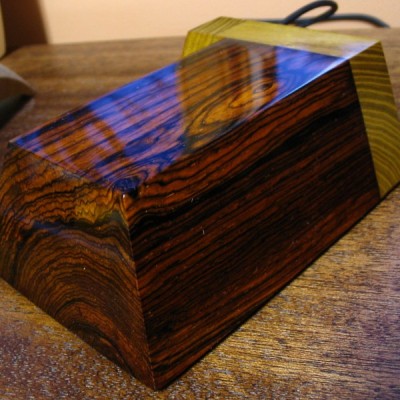
Can you see the end-grain?
Manufactured wood such as MDF, OSB, and particleboard all have a distinct look that is—in nearly all cases—easily distinguishable from the endgrain of real wood. Look for growth rings—formed by the yearly growth of a tree—which will be a dead-giveaway that the wood sample in question is a solid, genuine chunk of wood taken from a tree.
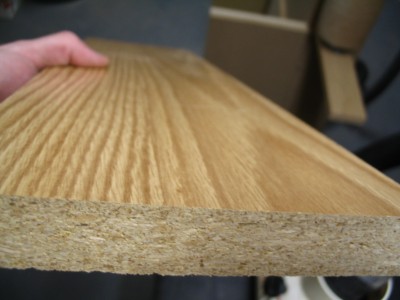
Is it veneered?
If you see a large panel that has a repeating grain pattern, it may be a veneer. In such cases, a very thin layer of real wood is peeled from a tree and attached to a substrate; sometimes the veneer can be one continuous repeating piece because it is rotary-sliced to shave off the veneer layer as the tree trunk is spun by machines. Assuming it is a real wood veneer with a distinct grain and texture—and not merely a piece of printed plastic—you may still be able to identify the outer veneer wood in question, but you should still realize that is it only a veneer and not a solid piece of wood.
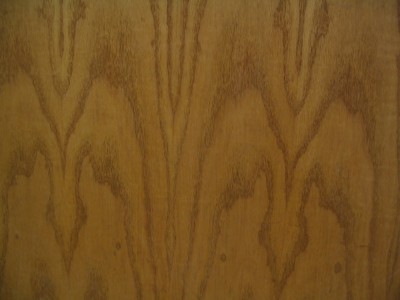
Is it painted or printed to look like wood?
Many times, especially on medium to large-sized flat panels for furniture, a piece of particleboard or MDF is either laminated with a piece of wood-colored plastic, or simply painted to look like wood grain. Many of today’s interior hardwood flooring planks are good examples of these pseudo-wood products: they are essentially a man-made material made of sawdust, glues, resins, and durable plastics.
2. Look at the color.
Some questions to immediately ask yourself:
Is the color of the wood natural, or is it stained?
If there is even a chance that the color isn’t natural, the odds are increased that the entire effort of identifying the wood will be in vain.
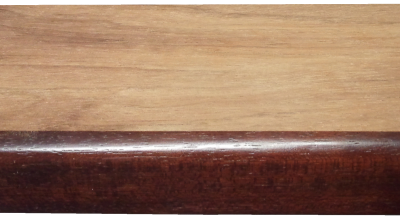
Is it weathered or have a patina?
Many woods, when left outside in the elements, tend to turn a bland gray color. Also, even interior wood also takes on a patina as it ages: some woods get darker, or redder, and some even get lighter or lose their color; but for the most part, wood tends to darken with age.
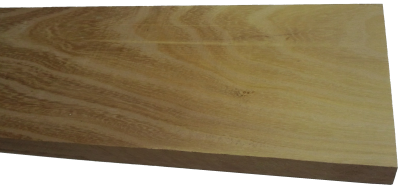
Is it possible to sand or plane the board to see the natural raw color of the wood?
The most predictable baseline to use when identifying wood is in a freshly sanded state. This eliminates the chances of a stain or natural aging skewing the color diagnosis of the wood.
3. Observe the wood grain.
If the wood is unfinished, then look at the texture of the grain. Ask yourself these questions:
Does the wood have an open, porous texture?
Most softwoods will be almost perfectly smooth with no grain indentations, while many common hardwoods have an open pore structure, such as oak or mahogany; though there are some hardwoods that are also smooth to the touch, such as maple.
Can you tell if the wood is quartersawn or plainsawn?
By observing the grain patterns, many times you can tell how the board was cut from the tree. Some wood species have dramatically different grain patterns from plainsawn to quartersawn surfaces. For instance, on their quartersawn surfaces, lacewood has large lace patterns, oak has flecks, and maple has the characteristic “butcher block” appearance.
Is there any figure or unusual characteristics, such as sapwood, curly or wild grain, burl/knots, etc.?
Some species of wood have figure that is much more common than in other species: for example, curly figure is fairly common in soft maple, and the curls are usually well-pronounced and close together. Yet when birch or cherry has a curly grain, it is more often much less pronounced, and the curls are spaced farther apart.
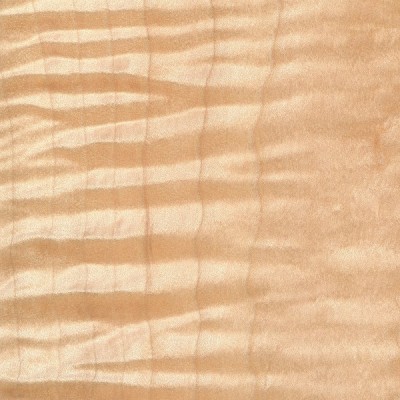
4. Consider the weight and hardness of the wood.
If it’s possible, pick the piece of wood up and get a sense of its weight, and compare it to other known wood species. Try gouging the edge with your fingernail to get a sense of its hardness. If you have a scale, you can take measurements of the length, width, and thickness of the wood, and combine them to find the density of the wood. This can be helpful to compare to other density readings found in the database. When examining the wood in question, compare it to other known wood species, and ask yourself these questions:
Is the wood dry?
Wood from freshly felled trees, or wood that has been stored in an extremely humid environment will have very high moisture contents. In some freshly sawn pieces, moisture could account for over half of the wood’s total weight! Likewise, wood that has been stored in extremely dry conditions of less than 25% relative humidity will most likely feel lighter than average.
How does the wood’s weight compare to other species?
Taking into account the size of the board, how does its weight compare to other benchmark woods? Is it heavier than oak? Is it lighter than pine? Look at the weight numbers for a few wood species that are close to yours, and get a ballpark estimate of its weight.
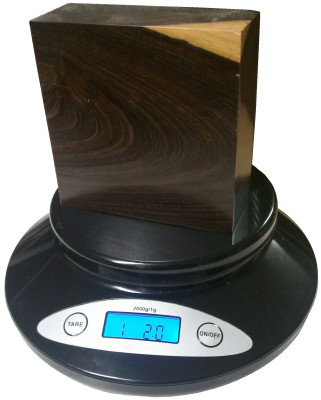
How hard is the wood?
Obviously softwoods will tend to be softer than hardwoods, but try to get a sense of how it compares to other known woods. Density and hardness are closely related, so if the wood is heavy, it will most likely be hard too. If the wood is a part of a finished item that you can’t adequately weigh, you might be able to test the hardness by gouging it in an inconspicuous area. Also, if it is used in a piece of furniture, such as a tabletop, a general idea of its hardness can be assessed by the number and depth of the gouges/dings in the piece given its age and use. A tabletop made of pine will have much deeper dents than a tabletop made of Oak. Additionally, you can always try the “fingernail test” as a rough hardness indicator: find a crisp edge of the wood, and with your fingernail try to push in as hard as you can and see if you’re able to make a dent in the wood.
5. Consider its history.
Many times we forget common sense and logic when attempting to identify wood. If you’ve got a piece of Amish furniture from Pennsylvania, chances are more likely that the wood will be made of something like black walnut or cherry, and not African wenge or jatoba. You might call it “wood profiling,” but sometimes it can pay to be a little prejudiced when it comes to wood identification. Some common-sense questions to ask yourself when trying to identify a piece of wood:
Where did it come from?
Knowing as much as you can about the source of the wood—even the smallest details—can be helpful. If the wood came from a wood pile or a lumber mill where all the pieces were from trees processed locally, then the potential species are immediately limited. If the wood came from a builder of antique furniture, or a boat-builder, or a trim carpenter: each of these occupations will tend to use certain species of woods much more often than others, making a logical guess much simpler.
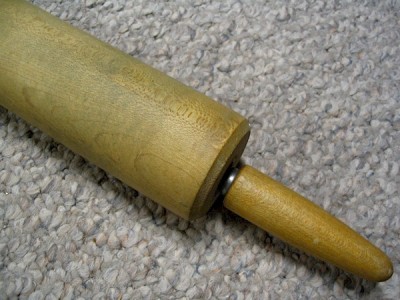
How old is it?
As with the wood’s source, its age will also help in identification purposes. Not only will it help to determine if the wood should have developed a natural patina, but it will also suggest certain species which were more prevalent at different times in history. For instance, many acoustic guitars made before the 1990s have featured Brazilian rosewood backs/sides, yet due to CITES restrictions placed upon that species, East Indian rosewood became a much more common species on newer guitars. (And this is a continuing shift as newer replacements are sought for rosewoods altogether.)
How large is the piece of wood?
Some species of trees are typically very small—some are even considered shrubs—while others get quite large. For instance, if you see a large panel or section of wood that’s entirely black, chances are it’s either painted, dyed, or stained: Gaboon ebony and related species are typically very small and very expensive.
What is the wood’s intended use?
Simply knowing what the wood was intended for—when considered in conjunction with where it came from and how old it is—can give you many clues to help identify it. In some applications, certain wood species are used much more frequently than others, so that you can make an educated guess as to the species of the wood based upon the application where it was used. For instance, in the United States: many older houses with solid hardwood floors have commonly used either red oak or hard maple; many antique furniture pieces have featured quartersawn white oak; many violins have spruce tops; many closet items used aromatic red cedar, and so forth. While it’s not a 100% guarantee, “profiling” the wood in question will help reduce the number of possible suspects, and aid in deducing the correct species.
6. Find the X-Factor.
Sometimes, after all the normal characteristics of a sample have been considered, the identity of the wood in question is still not apparent. In these instances—particularly in situations where a sample has been narrowed down to only a few possible remaining choices—it’s sometimes helpful to bring in specialized tests and other narrower means of identification.
The following techniques and recommendations don’t necessarily have a wide application in initially sorting out wood species and eliminating large swaths of wood species, but will most likely be of use only as a final step in special identification circumstances.
Odor
Believe it or not, freshly machined wood can have a very identifiable scent. When your eyes and hands can’t quite get a definitive answer, sometimes your nose can. Assuming there is no stain, finish, or preservative on or in the wood, quickly sand, saw, or otherwise machine a section of the wood in question, and take a whiff of the aroma.
Although new scents can be very difficult to express in words, many times the scent of an unknown wood may be similar to other known scents. For instance, rosewoods (Dalbergia spp.) are so named for their characteristic odor that is reminiscent of roses. Although difficult to directly communicate, with enough firsthand experience scents can become a memorable and powerful means of wood identification.
Fluorescence
While certain woods can appear basically identical to one another under normal lighting conditions, when exposed to certain wavelengths—such as those found in blacklights—the wood will absorb and emit light in a different (visible) wavelength. This phenomenon is known as fluorescence, and certain woods can be distinguished by the presence or absence of their fluorescent qualities. See the article Fluorescence: A Secret Weapon in Wood Identification for more information.
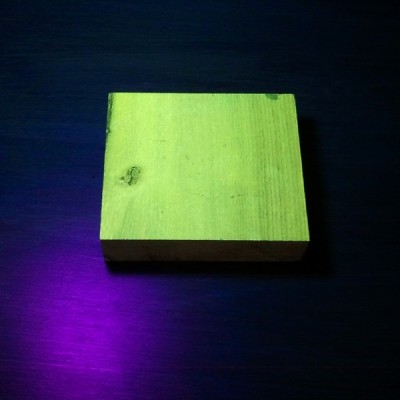
Chemical Testing
There are only a small number of chemical tests regularly used on wood, most of which are very specialized and were developed to help distinguish easily confused species with one another. They work by detecting differences in the composition of heartwood extractives. A chemical substance (called a reagent) is usually dissolved in water and applied to the wood surface: the surface is then observed for any type of chemical reaction (and accompanying color change) that may occur. Two of the most useful are the tests that are meant to separate Red and White Oak, and Red and Hard Maple.
Heartwood Extractives Leachability
Sometimes a wood species will have heartwood extractives that will be readily leachable in water and capable of conspicuously tinting a solution of water a specific color. For instance, the heartwood extractives contained in osage orange (Maclura pomifera) contain a yellowish-brown dye that is soluble in water. (This can sometimes be observed anecdotally when the wood is glued with a water-based adhesive: the glue’s squeeze-out is an unusually vibrant yellow.)
In a simple water extract color test, wood shavings are mixed with water in a vial, test tube, or other suitably small container, and the color of the water is observed after a few minutes. If the heartwood extractives are leachable by water, then a corresponding color change should quickly occur.
In addition to osage orange (Maclura pomifera), merbau (Intsia spp.), and rengas (Gluta spp. and Melanorrhoea spp.) are also noted for their readily leachable heartwood extractives. Because this property is quite uncommon, it can serve to quickly differentiate these woods from other lookalikes.
7. Look at the endgrain.
Perhaps no other technique for accurate identification of wood is as helpful and conclusive as the magnified examination of the endgrain. Frequently, it brings the identification process from a mostly intuitive, unscientific process into a predictable, repeatable, and reliable procedure.
Looking at the endgrain with a magnifier shouldn’t be a mystifying or esoteric art. In many cases, it’s nearly as simple as examining small newsprint under a magnifying glass. There are three components necessary to reap the full benefits contained in the endgrain:
I. A prepared surface.
When working with wood in most capacities, it becomes quickly apparent that endgrain surfaces are not nearly as cooperative or as easily worked as face grain surfaces. However, in this case, it is absolutely critical that a clear and refined endgrain surface is obtained.
For a quick glance of a softwood sample, a very sharp knife or razor blade can be used to take a fresh slice from the endgrain. However, in many denser species, especially in tropical hardwoods, one of the best ways to obtain a clear endgrain view is through diligent sanding. It’s usually best to begin with a relatively smooth saw cut (as from a fine-toothed miter saw blade) and proceed through the grits, starting at around 100, and working up to at least 220 or 320 grit, preferably higher for the cleanest view.
II. The right magnifier.
It need not be expensive, but whatever tool is used to view the endgrain should have adequate magnifying power. In most instances, 10x magnification is ideal, however, anything within the range of 8 to 15x magnification should be suitable for endgrain viewing. (Standard magnifying glasses are typically in the range of 2 to 4x magnification.)
These stronger magnifiers, sometimes called loupes, usually have a smaller viewing area than standard magnifying glasses. Fancier models—with built in lights, or larger viewing surfaces—are available at a premium; but the most basic models are usually only a few dollars.
III. A trained eye.
The third element that constitutes a proper endgrain examination is simply knowing what to look for. In analyzing the patterns, colors, shapes, and spacing of the various anatomical features, there is a veritable storehouse of information within the endgrain—all waiting to be unlocked. Yet, if these elements have not been pointed out and learned, the array of features will simply seem like an unintelligible jumble. The discipline of recognizing anatomical endgrain features is not easily summed up in a few sentences or even a few paragraphs, but it is nonetheless critical to the identification process. To this end, an in-depth look should be given to the various categories, divisions, and elements that constitute endgrain wood identification on the macroscopic level. (In this regard, macroscopic denotes what can be seen with a low-powered, 10x hand lens—without the aid of a microscope—rather than simply what can be seen with the naked eye.) Because the anatomy between softwoods and hardwoods is so divergent, each will be considered and examined separately:Still stumped?
If you have a mysterious piece of wood that you’d like identified, you’ve got a few options for next steps:USDA’s Forest Products Laboratory
You can mail your physical wood samples to the Center for Wood Anatomy Research.
Pros:
- Free
- Professional wood identification
Cons:
- Only available to US citizens
- Slow turnaround times (up to a month or more)
- Limited to three IDs per year
See their Wood ID Factsheet for more info.
Alden Identification Service
You can mail your physical wood samples (even small sections taken from antiques) to Alden Identification Service.
Pros:
- Professional wood identification
- Faster turnaround times (ranging from a few days to a week or two)
Cons:
- Paid service
See their ordering page for more info. (Note that Harry Alden has written several books while at USDA, including both Hardwoods and Softwoods of North America.)
Ask for help online
If the wood ID is merely a curiosity, or non-critical, you can post pictures of the wood in question.
Pros:
- Free
- No need to send physical samples
Cons:
- Greatly limited by the quality of the pictures provided
- Extra work usually required to get adequate clarity in photos
See article of Common US Hardwoods to help find the most commonly used woods.
Get the hard copy
 If you’re interested in getting all that makes The Wood Database unique distilled into a single, real-world resource, there’s the book that’s based on the website—the Amazon.com best-seller, WOOD! Identifying and Using Hundreds of Woods Worldwide. It contains many of the most popular articles found on this website, as well as hundreds of wood profiles—laid out with the same clarity and convenience of the website—packaged in a shop-friendly hardcover book.
If you’re interested in getting all that makes The Wood Database unique distilled into a single, real-world resource, there’s the book that’s based on the website—the Amazon.com best-seller, WOOD! Identifying and Using Hundreds of Woods Worldwide. It contains many of the most popular articles found on this website, as well as hundreds of wood profiles—laid out with the same clarity and convenience of the website—packaged in a shop-friendly hardcover book. 





Why I will no longer be replying to every wood ID request I’ve replied to literally thousands of wood ID requests on this site over the past 13+ years, but as the site’s popularity has grown, so has the time demands for ID on a daily basis. (Contrary to what some may seem to think, I am not some all-knowing wood wizard that can instantly ID your wood. It can actually take me a long time to sift through a lot of different resources.) Over the past few years, my backlog of pending wood species to be added to the… Read more »
Hi Eric, I have a wooden bowl and I’m curious about its material. It has a silver handle, therefore I would suppose it’s not the simplest/cheapest wood. I’m living in Hungary, Europe, but maybe the wood is not from Europe. Based on the carvings and the pattern it must be hardwood. Its colour is close to oak (look at that photo where the bowl is on an oak tabletop, whatever oak it is). It also has greenish-gray parts (see pics about its bottom), and definit dark strips. It has a bit shiny surface along the grain, as I removed the… Read more »
Hi eric, can u help me identify my statue,
It was inherited by my father
It already 15 years old or even more
Hello, I purchased a used coffee table yesterday and have no idea what type of wood it is or where the wood might derive from. Initial belt sanding (80 grit) has removed the applied top layers revealing a reddish overall tone (brick dust-ish) with variations ranging from blond to black. There is nothing remarkable about the scent of the wood. It is extremely heavy and I doubt that it would float. I am in Alberta, Canada and the former owner is from Ontario. Thank you in advance.
A softwood of some sort. Possibly pine or fir.
Hi Eric, Before I send a sample of this wood for professional identification I’m hoping you might be able to help. I have about 100 board feet of this species. It was all rescued from demolition while renovating/restoring an 1887 home in San Antonio. The house was built and owned by a relatively wealthy couple, so the wood was most likely imported. The wood was used for very large drawers (3 ft x 5 ft in size). Some single boards are as large as 72″ long, 13″ wide, and 3/4″ thick (no laminations or butt joints). It was also used… Read more »
Light weight, diffuse porous, visible rays, greenish color, and very wide, defect free boards. To me, this is a textbook example of yellow poplar.
Hi Eric, hi all. My father gave me a piece of this wood and, for some personal reasons, this means the whole world to me. So any help in identifying the species would be hugely appreciated! I was initially told that this is African pear(wood) but I have several reasons to doubt this (mostly the weight). Apparently the wood was used in coal mining industry for some heavy duty tasks (therefore possibly not very expensive). Nevertheless, the wood is heavy (1.02 kg per cubic meter – measured on two samples), it sinks in water and it takes sanding extremely well… Read more »
I don’t think this is moabi. The endgrain on your sample was winged parenchyma, with moabi does not. Who told you it was African pear?
Chances are it is a less common species not even on this site (yet).
Thank you so much for your reply, I really appreciate it. Will try to find out what this is.
Greetings Eric, I’m a rookie just starting out with wood works and restoration (almost greener than a sprout here). While I usually can tell real wood from the rest and pick more or less its density/weight, I am cluless regarding overall species, colourations and patterns. A bar came into my possession not long ago, and I know for a fact this was lost inside a container coming straight from Indonesia (Bali), so I know the wood at least to be exotic (seems to have decent density and weight, it’s pratically in its natural colour and seems rubbery/spongy?) But other than… Read more »
Very hard to tell, tropical woods can be really tough, though knowing the source is helpful. Can you get a picture of the endgrain?
Sorry it took me longer to reply, was out of town.
Here are a few pictures of the end grain and quarter as well, hopefully it helps to shed some light on the matter:
Hi Eric! Any chance you are able to tell what this wood is? It’s a cabinet I got from my relatives and unfortunately I don’t know anything about it. Thanks!
Do you know what this is wood or veneer? This is my question after looking on various sites I just don’t know? it’s my kitchen cabinets and drawers 20 years old
What geographic region is your house located? (Or even what country.)
North Yorkshire England
It is not veneer. It looks solid to me.
Hi Eric. Can you please help me out here. I believe this piece of wood might be Gosweilerodendron balsamiferum. But since you do not have yet this specie characteristics on your website I cannot confirm it since I have no ingrain photos to compare to… Appreciate you expert note on the matter. Density of 460 kg/m3. Regards.
Gosweilerodendron balsamiferum is definitely a possibility. But most sources say that it has a distinct odor, some say it is pepper-like. Avodire is another possibility.
Hello Eric. I wonder if you can help me with this specie. It looks like a mahogany ( I know, a too generic name), it is oily when we work with it (just like tigerwood – but lacking any of its distinctive two colours), its density is 717 Kg/m3, and odor its not characteristic since it was part of a very large wine barrel (it currently only smells of wine :-). The color it presents in the photos is from its inner side – the lighter version of the piece, which i believe has not been altered. Regards.
The marginal parenchyma does seem to suggest Swietenia genus mahogany. I don’t know about the comments on oiliness though, that seems to be a confounding variable.
Hi there follow up from my last post, I’ve managed to skim the end grain to get a nice clear photo. Once again, no distinct odour from what I can tell, perhaps a generic musky wood smell. The saw really struggled even on this small stock. Very porous stuff. Hoping the sapwood/heartwood boundary helps with the ID. Many thanks!
It almost looks like some kind of padauk (Pterocarpus genus) or even rosewood (Dalbergia genus), but you said there wasn’t much smell, so I’m not sure.
It definitely sinks in water I just tested it. I have only three ideas having really looked through your database and also around. Ipe, Knobthorn and Cumaru. Maybe you could tell me what you think of these suggestions? Many thanks for taking the time Eric.
The fact that there is sapwood is a clue in and of itself. I don’t think I’ve ever even seen sapwood included on boards of ipe or cumaru. Since they are commonly used for exterior purposes, and sapwood is virtually never rot resistant in any species, I suppose this makes sense.
Chances are it is another, less common species that may not even be listed on this site. You might want to test for fluorescence as a next step. https://www.wood-database.com/wood-articles/fluorescence-a-secret-weapon-in-wood-identification/
Good afternoon. I just received a large package of very old stock wood. 3 of the pieces were marked as “dense” instead of their species. I have NO CLUE. very hard with the nail test, no distinct smell upon sanding, density only slightly above water’s (I’d guess max 1100kg/m3), any the end grain is sealed thick with wax so it’s impossible to see. Even just an idea will direct me to IDing myself.
Another thing I noticed is small horizontal bands like you see in beech, sapele, maple
Looks like a tropical hardwood with large, diffuse pose. One of the hardest categories of wood to ID. If you’re sure it will actually sink in water (I would literally check if they sink) that would help narrow things down. But I would still check the endgrain before laboring too hard to find an ID. Nothing sticks out as obvious at this point.
I found this board in a sheep barn in Del Rio, TX. It was a bit over 8 Ft long, 8 inches wide and 2.5 inches thick. I cut the board in two, and put one of the 4ft pieces through my thickness planer. It looks like pine … but is dense and heavy, and does not smell like pine. It was originally ruff sawn, as circular saw marks were visible. The only tree that grow in this area are mesquite, pecan, sycamore, and a few cypress along the Rio Grande River. I am pretty well versed in trees, lumber,… Read more »
Well initially I’d say it looks pretty close to maple, but I can’t see enough of the details of the endgrain. Would need to see a finely sanded closeup picture of the endgrain to have a better chance at ID.
Hello, could you please help identify what wood is this?
Can anyone please help me here? This is a wooden step in the front porch of a 30 years old Japanese house that I bought last summer. Such a step is pretty important in Japanese traditional house design, so I would not be surprised if the carpenter used relatively expensive wood, either domestic or imported. I think I’ve managed to identify all the other kinds of wood used in the house except for this step. Initially I thought it would be an easy one, but after searching through hundreds of images on the web, and reading several articles on this… Read more »
Yes, as you’ve said, it’d be very difficult to positively ID without seeing the endgrain. At the very least, it does look like a tropical hardwood with interlocked grain, and the step appears to be quartersawn with a ribbon stripe figure. Perhaps there is a short(er) list of woods that are more commonly used in Japan for this application? That would go a long way in narrowing things down. Since it’s in the Pacific, and it’s a very large slab, I think it more likely to be something imported from a shorter distance, rather than farther away. One possibility would… Read more »
Eric, thank you so much for your help! I am now 90% sure it is a Shorea species, which is called “rawan” in Japanese. I have now found a few images of “rawan” boards with pretty similar grain pattern. Japan has been importing huge quantities of wood from Malaysia, Indonesia and the Philippines, most of it being various Shorea species, marketed as Lauan/rawan. 30 years ago, when the house was built, there were plywood plants operating nearby, which used the imported logs to make “rawan” plywood. The carpenter could have easily (and cheaply) obtained a large slab there. By the… Read more »
Would you mind helping me identify the floorboards in my new home?
Looks like a softwood species of some sort, such as pine or fir. I’m not sure what would be commonly used in your area.
Thank you!
Can anyone help identify this wood? It’s from a kitchen cabinet.
Looks like a rotary-cut softwood veneer like pine or fir.
What type of wood is this oak
It’s a softwood, I’d guess something like Douglas fir or larch.
Hi can anyone help with what wood this is please I have sanded it down to bare wood but no idea
Hi Eric. I wonder if you could help me identifying this wood sample. It came from a very old bed side rail. It seems to me of the quercus type due to its parenchyma specific shapes. Thus, its ingrain does not seem to match any of the examples your website contains. Colour its a puzzling thing also although I may admit being a old piece it may show severe oxidation…
Pretty puzzling. Because it is diffuse porous without annual growth rings, that would rule out most oaks (except for live oaks). But live oak’s pores tend to occur in radial or dendritic patterns, and this appears to have completely random pore distribution. Superifically it looks closest to sheoak from Australia, but they have banded parenchyma, which your sample lacks. It honestly looks closest to stone oak (Lithocarpus genus) which are native to east Asia, so not that plausible being in Portugal. I’m stumped. It may end up being a species of live oak after all, or possibly some obscure species… Read more »
I can’t identify this wood on my custom Kitchen cabinets installed in the 60s can anyone help?
If I had to guess, judging by the birds-eyes, I’d guess it was birdseye maple stained a dark almost walnut color.
Thank you Eric
That was my and a few others best guess too. I really appreciate your help.
Paul
I’d love some help identifying the flooring in this house built around 1900. I believe these floors are original. Thank you!
Hi got a table.Any chance you are able to tell what this wood is? Thx a lot
Please could someone help me identify the two different types of wood in this table? Thanks I’m advance
Little hall table with an interesting grain, quarter sawn maybe? Any clue what kind of wood? stain seems a bit reddish, almost pinky/purple in the light.
Hallo, could someone help me identify the wood of this large and heavy African sculpture?
Thank you
Made a bowl out of scrap wood I salvaged from a fire pile. When I got the piece, the exposed endgrain was a dark reddish hue. I was surprised when I cut the blank that the heartwood was greenish/yellow in color. Someone suggested mulberry, but the endgrain comparisons I’ve seen don’t seem to match.
Looks unusual. It’d be interesting to see if it fluoresces under a blacklight. https://www.wood-database.com/wood-articles/fluorescence-a-secret-weapon-in-wood-identification/
It sort of looks a bit like laburnum to me. Pistachio is another possibility, though that wood has a distinct odor. Do you have any shots of the face grain?
Here are a couple pictures of the log I cut it out of and the bowl so you can see the color change better.
Thanks!
Hi. Any chance you are able to tell what this wood is? It’s a cabinet I got at a goodwill store. Was planning to sand it all and then stain or just seal it but idk if it’s worth the effort.
Looks like pine. I can see what appear to be the resin canals on the face grain of the wood as intermittent thin dark lines. Probably not worth much monetary-wise, but if you like it, then go for it.
Any idea what this wood is? It has Danish oil applied to it. It came with the house and I would like to use the same type on another wall. It was installed within the last five years by the owner who is a contractor.
I recently sanded back a coffee table top to bare. It comes out with red brown tone timber and white sapwood in it. I am from Queensland Australia. The only thing I can tell it is not soft wood. Wonder if you can tell what kind of timber it is? Many thanks
this table top is wood veneer and i need to replace it with a similar piece. i think it is either birch or maple.. since i am replacing it i’m not sure it will matter, but hopeing to replace with the same type of wood.
any ideas?
I’m going to guess birch since I can’t see any signs of ray fleck anywhere on the piece, especially the quartersawn portions. Bot look very similar though, so I’m sure either one will look okay provided that the stain/finish color is matched well.
Not sure what wood this is and if it is solid or old thick veneer. Google lens says it could be mahogany
It’s just a mahogany-colored stain. Hard to tell since it doesn’t appear to be a natural wood color.
I would like to refinish this circa 1983 piano. I know it is wood veneer but am looking to find out what type of wood the veneer is made out of. Any help is greatly appreciated!
Looks like oak veneer.
Thank you!!
Thank you!
Hello, I want to match my lounge doors with some shelving .. and I’m no wood expert. Can someone advise me what this is so I can start my exploration of shelving .. thank you in advance !
A softwood of some sort, possibly knotty pine or fir.
Thanks Eric, appreciate that .. ! Have a good day
I need to match up and replace some wood veneer 3-ply 1/4″ plywood paneling (with the top ply being the veneered layer) for a repair job. I’m guessing this is the kind of paneling that was fairly inexpensive and sold in the big box stores about 20 or 30 years ago. This paneling is stained of course but I sanded part of what is shown in the picture, to reveal the blonder wood underneath. To start me off, can anyone suggest what kind of wood this veneer is? If you can suggest who the manufacturer of the 4×8-ft panels might… Read more »
Looks like lauan, which is wood from Shorea genus. Sometimes called “Philippine mahogany” though it’s not true mahogany.
Thank you for the quick, nay,
IMMEDIATE reply, Eric!
I’ve been looking online for similar finished paneling, and because styles have changed it’s hard to find. But I did find something at Home Depot that from the pictured photograph looks very similar to an unstained version of this same paneling.
Their product is noted as being eucalyptus. Is it possible that from the pictures I sent you this actually might be some species of eucalyptus – lyptus or ‘Red Mahogany’?
I suppose it’s a possibility, but I really think the likeliest candidate is Shorea. But if it looks similar to you, then just use that. In these sorts of cases, close usually counts.
From my late father’s wood. Very heavy.
Looks closest to elm to me.
Thanks so much! We are making it into a small counter top. Can you recommend what type of durable finish we should use? Would clearcoat be ok?
Best guess on the species of my fixed panels vs operable doors and drawers are? New build and we went with what were told was real wood cabinetry vs MDF. MDF being significantly cheaper and therefore lower quality. Operable panels reflect the stain and grain we selected. Fixed however DO NOT .Warmer tone and totally different grain pattern.that to me appears unnatural. We wanted the wood used throughout our home to all match. Any insight appreciated. TIA
Found in my loft in London. Any thoughts welcome.
This was discarded by a homeowner with a sign saying ” free firewood”. I picked it up, dowelled and wood glued it together, planed it flat, sanded and finished with spar vanish. Wanting to know its origin. No strong odor was evident during my working the wood. It has 70+ rings and is 38 inches across. Rather heavy.
I’m trying to identify a piece of hardwood that was reclaimed from some stairs. From their style I’m guessing that these were built in the 70’s in the Netherlands. The boards measure approx 75cmx23cmx3,4cm, weighing 4 kilos, which would make 690kg/m3 (or 43lbs/ft3). I’ve attached some photos of a planed and lightly sanded part of the face grain. For reference, the table it is lying on is oak (probably European). The color is a somewhat light brown with a greenish hue in some angles. The grain-direction seems to vary a bit between the darker and lighter parts of the wood.… Read more »
Thanks for the good pics on this. I would agree that iroko seems like the most likely candidate. The only other option that I can think of that can sometimes have a slightly greenish hue and looks pretty similar is afrormosia.
Thanks Eric. I’ve looked at Afrormosia, and that is described as having a distinctive smell. This wood doesn’t really have much of a smell at all when being planed or sanded. So I’m guessing I’ll call it Iroko then :)
I also noticed that there was quite a lot of dust being created when planing it; more than I’m used to with oak or softwoods. And I also noticed that the dust felt a bit sticky, almost oily, difficult to describe. Perhaps this is normal for tropical hardwoods?
Can you identify the type of wood? Antique vanity with mirror. Previous owner thought it is mahogany. I’ve stripped off the sealer with plans to restore.
Hard to tell from the pics, but superficially I would agree that the grain and color are at the very least consistent with mahogany.
Trying to identify this wood. It was stained but a few years ago the top and drawer front was sanded.
Where are you located or what geographic region did you acquire this piece?
I’m in Canada. The piece was in my parents house. No idea where it came from. It’s probably a handmedown from a relative but no idea which one. My relatives span from the US to England and the Nordic countries.
It’s a softwood species, probably a species of southern yellow pine.
Hi Eric-
This is an old door I bought at a local salvage store. No provenance available.
The inset panel has a lacy appearance and the frame has been milled to a very fine, grooved texture. There are several kinds of Oak trees in this region. Wondering if it may be that???
Thanks!
It’s a softwood. Based on your location, most likely Douglas fir.
Thanks very much!
Trying to determine species
Hi Eric. Congratulations for your website. I’ve been finding it quite helpful in clarifying some wood identification doubts I do have.
I wonder if you can help me out figuring which wood could be this one seen in the photos.
It visually looks very much like Bowdichia nitida wood (sucupira). Although darker, and more significantly, much less denser (this sample is around 600kg/m3).
Hmm, interesting, I’m stumped. Those whitish deposits in the pores are very distinctive, and not commonly seen. I’m a bit thrown off by the appearance though. The facegrain looks similar to patridgewood or brownheart, which have a unique striped appearance on account of the extensive contrasting parenchyma, yet on the endgrain image, I can’t see much parenchyma at all. Merbau is also similar with mineral deposits in the pores, but is much heavier.
Not Wenge?
No, wenge has very wide parenchyma bands which this wood lacks.
Hi Eric. Many thanks for your reply. It is puzzling indeed. The low density of this samples does not appear to match any of the most common commercial woods.
By the way, I may have mislead you when I Posted the question regarding the wood origin. Its surely a specie either from South America of from Africa (not Portugal).
I found this in my dad’s woodpile and planed it down
I got several boards from a used shipping crate with Indonesian pallet stamps and I’m curious hat they might be. Any help would be appreciated! My thumbnail will score a line. The roughest, most weathered parts of the wood were very orange or even purple, but mostly it was a shimmery brown. The color faded to interesting stripes when sanded. At 320 sanding, the wood looks striped and I see what looks like little pixels all over the face.
The wood looks curiously similar to mahogany, though based on its use and location I very much doubt that it is genuine Swietenia spp. mahogany.
Pallets and crates can be very tough because often they are made domestically from lesser-known local utility woods that may not necessarily be traded in the international market, and are therefore unknown to the rest of the world.
I appreciate you having a look. And can I just say how much I enjoy this website! So much information, so clearly presented.
Just wondering if anyone can help me identify this stump? Please and thank you. ?
Looks like a softwood species. I can’t see any resin canals, so that would rule out pine (unless the photo itself just lacks the necessary detail to see them). Possibly something like fir or hemlock.
Are they the little holes that look like worms crawled through?
Not really, I’d say resin canals are even smaller. https://www.wood-database.com/wood-articles/softwood-anatomy/#resin_canals
Like these?
No.
I have a wood walking stick that was reputably owned by David Lloyd George, the British Prime Minister from WW1 vintage. I think the stick is younger than this, possibly the late 1930s. I am wondering what wood it is made from?